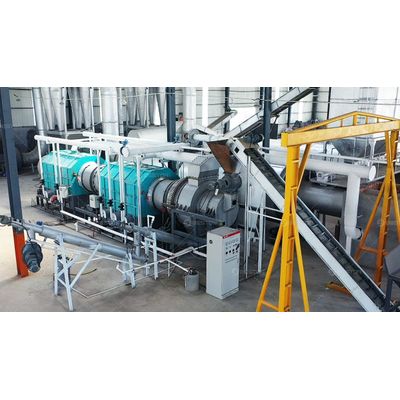

- Home
- Companies
- Beston Group Co., Ltd.
- Articles
- Operation Process of Biochar Production ...

Operation Process of Biochar Production Equipment
The operation of biochar production equipment involves a series of meticulously controlled processes that transform organic biomass into a valuable byproduct. Biochar, a stable form of carbon, is created through the thermochemical conversion of organic materials in the absence of oxygen, commonly referred to as pyrolysis. This process not only reduces waste but also yields a product that has significant benefits in agriculture, carbon sequestration, and waste management. Below is an overview of the key steps involved in the operation of biochar production equipment.
1. Biomass Feedstock Preparation
The first step in the biochar production process is the preparation of the biomass feedstock. The raw material used in the production of biochar can vary, including agricultural waste, forestry residues, and even certain types of organic municipal waste. The feedstock must be processed to a consistent size for efficient pyrolysis. Typically, the material is shredded or ground to ensure uniformity. The moisture content of the feedstock is also an important factor—biomass with high moisture content can negatively affect the pyrolysis process, leading to inefficient production and lower-quality biochar. Drying the biomass, either through natural or artificial methods, is often necessary before the material enters the reactor.
2. Feeding the Biomass into the Reactor
Once prepared, the biomass is fed into the pyrolysis reactor. In biochar production equipment, this is usually achieved via a conveyor system or manually, depending on the size and scale of the operation. The feedstock is loaded into the reactor where it will undergo pyrolysis. The reactor is designed to maintain a controlled temperature, which is essential for the conversion of the biomass into biochar. In modern biochar production equipment, automated systems regulate the flow of biomass into the reactor and control the heating elements.
3. Pyrolysis Process
Pyrolysis is the heart of the biochar production process. In the absence of oxygen, the biomass is subjected to high temperatures, typically between 400°C and 700°C, depending on the desired characteristics of the biochar. During pyrolysis, the biomass decomposes into three main byproducts: biochar, bio-oil, and syngas. The biochar is the solid carbon-rich residue that remains after the volatile compounds have been removed.
The pyrolysis process is highly dependent on temperature, heating rate, and residence time in the reactor. The biochar production equipment must maintain a precise temperature profile to ensure that the conversion is efficient and the resulting biochar meets the desired specifications. Advanced pyrolysis reactors often incorporate systems for heat recovery, allowing for the utilization of the heat produced during the process to improve energy efficiency.
4. Gaseous Byproduct Collection and Treatment
As the biomass undergoes pyrolysis, volatile gases such as carbon dioxide (CO2), carbon monoxide (CO), methane (CH4), and other hydrocarbons are released. These gases can be captured and either processed further or used as fuel for the pyrolysis system itself, enhancing the overall energy efficiency of the process. In many biochar production systems, a gas cleaning and cooling system is integrated to remove impurities and moisture from the syngas before it is either condensed into bio-oil or utilized as a fuel source.
The treatment of gaseous byproducts is an important consideration, as the release of unprocessed gases into the atmosphere can contribute to air pollution. Advanced biochar reactor often includes filtration and scrubbing systems that reduce emissions and meet regulatory standards.
5. Biochar Cooling and Storage
After the pyrolysis process is complete, the biochar is still hot and must be cooled down to ensure its stability and prevent any combustion in contact with oxygen. The cooling phase is often achieved using a cooling system that reduces the temperature of the biochar, ensuring it is safe to handle and store. Once cooled, the biochar is removed from the reactor and prepared for packaging or further use.
Depending on the scale of production, biochar can be either bulk stored or packaged for sale in bags. The quality of the biochar produced depends heavily on the control of the pyrolysis process, the type of biomass used, and the post-production handling. High-quality biochar has a porous structure and a high surface area, making it ideal for applications such as soil amendment, water filtration, and carbon sequestration.
6. Maintenance and Operational Monitoring
Regular maintenance and operational monitoring are essential for ensuring the continued efficient operation of biochar production equipment. Sensors are often integrated into the system to monitor parameters such as temperature, gas composition, and flow rates. Operators can adjust settings based on real-time data to optimize the process and prevent potential issues such as overheating or clogging of the system. Additionally, the equipment requires periodic maintenance to keep the reactor and other components in good working order. This ensures that the equipment remains efficient and compliant with environmental regulations.
Conclusion
The operation of biochar production equipment involves a series of critical steps that require careful control and optimization. From feedstock preparation to the cooling and storage of biochar, each phase is designed to ensure the production of high-quality biochar while minimizing environmental impact. With proper operation and maintenance, biochar production equipment can provide a sustainable solution for waste management, renewable energy generation, and soil improvement, offering significant ecological and economic benefits.
